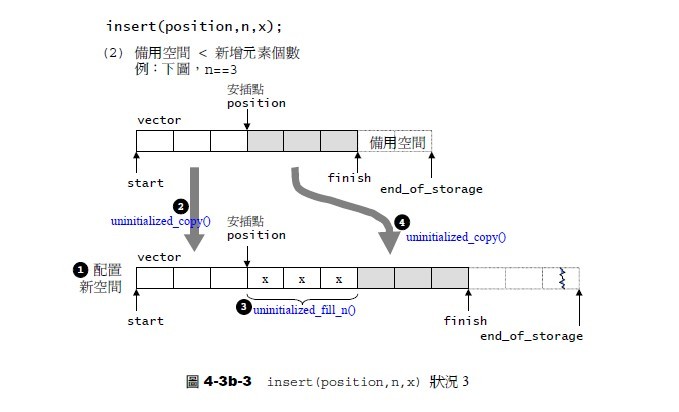前言
项目组要实现一个算法库,其中涉及到了类似vector的一维数组的实现。特此,对stl中得vector做个学习和了解。有任何问题,欢迎不吝指正。谢谢。
一、如何实现vector
如果给你一道面试题,如何用数据结构实现STL中vector的功能?聪明的你会怎么做呢?或许你会如下所述:
- 或许,如果不考虑分配效率,只需要两个成员就可以实现了
template
class Vector
{
public:
Vector(int nLen=0):m_nLen(nLen),m_Data(NULL)
{
if(nLen > 0)
{
m_Data = new _Ty[nLen];
}
}
protected:
_Ty * m_Data;
int m_nLen;
}; - 或许,如下一个简单的思路实现:
#include
using std::ostream;
using std::istream;
class Array {
friend ostream &operator < <( ostream &, const Array & );
friend istream &operator> > ( istream &, Array & );
public:
Array( int = 10 );
Array( const Array & );
~Array();
int getSize() const;
const Array &operator=( const Array & );
bool operator==( const Array & ) const;
bool operator!=( const Array &right ) const
{
return ! ( *this == right );
}
int &operator[]( int );
const int &operator[]( int ) const;
private:
int size;
int *ptr;
}; - 或许你会说,应该用模板写。当数组大小变化时,就直接new 当前大小,将旧有的或拷贝或加入新的东西加入,然后删除旧有的m_pData;并更新m_nLen;
当数据大小不变化时,直接使用m_pData;。如果考虑分配效率,则还需要一个成员存储m_nMaxLen;实际的分配大小。 要记住一定删除旧的m_pData就可以。
很快,你就会意识到,与其这样不知方向的摸着石头过河,不如直接拿来stl里的vector实现代码,来瞧个究竟。ok,下面,咱们来剖析下stl vector的实现。其中的分析借助了侯捷先生的stl源码剖析(大凡研究sgi stl源码,此书都不容忽略),然后再加入一些自己的理解。希望对你有所帮助(下面咱们分析的版本是sgi stl v2.9版)。
二、vector的类定义
以下是vector定义的类中的一些数据成员和部分成员函数:
- template <class t="" class="" alloc="alloc">
- class vector {
- public:
-
- typedef T value_type;
- typedef value_type* pointer;
- typedef const value_type* const_pointer;
- typedef const value_type* const_iterator;
- typedef value_type& reference;
- typedef const value_type& const_reference;
- typedef size_t size_type;
- typedef ptrdiff_t difference_type;
-
-
- typedef value_type* iterator;
-
-
-
-
-
-
-
-
-
- protected:
-
- typedef simple_alloc<value_type alloc=""> data_allocator;
-
-
-
-
- iterator start;
- iterator finish;
- iterator end_of_storage;
-
- void insert_aux(iterator position, const T& x);
- void deallocate() {
- if (start)
- data_allocator::deallocate(start, end_of_storage - start);
- }
-
- void fill_initialize(size_type n, const T& value) {
- start = allocate_and_fill(n, value);
- finish = start + n;
- end_of_storage = finish;
- }</value_type></is></is></shape></em></class>
下面是另外一些成员操作函数的具体实现,
- public:
- iterator begin() { return start; }
- const_iterator begin() const { return start; }
- iterator end() { return finish; }
- const_iterator end() const { return finish; }
- reverse_iterator rbegin() { return reverse_iterator(end()); }
- const_reverse_iterator rbegin() const {
- return const_reverse_iterator(end());
- }
- reverse_iterator rend() { return reverse_iterator(begin()); }
- const_reverse_iterator rend() const {
- return const_reverse_iterator(begin());
- }
- size_type size() const { return size_type(end() - begin()); }
- size_type max_size() const { return size_type(-1) / sizeof(T); }
- size_type capacity() const { return size_type(end_of_storage - begin()); }
- bool empty() const { return begin() == end(); }
- reference operator[](size_type n) { return *(begin() + n); }
- const_reference operator[](size_type n) const { return *(begin() + n); }
-
- vector() : start(0), finish(0), end_of_storage(0) {}
-
- vector(size_type n, const T& value) { fill_initialize(n, value); }
- vector(int n, const T& value) { fill_initialize(n, value); }
- vector(long n, const T& value) { fill_initialize(n, value); }
- explicit vector(size_type n) { fill_initialize(n, T()); }
-
- vector(const vector<t alloc="">& x) {
- start = allocate_and_copy(x.end() - x.begin(), x.begin(), x.end());
- finish = start + (x.end() - x.begin());
- end_of_storage = finish;
- }
-
- template <class inputiterator="">
- vector(InputIterator first, InputIterator last) :
- start(0), finish(0), end_of_storage(0)
- {
- range_initialize(first, last, iterator_category(first));
- }
-
- vector(const_iterator first, const_iterator last) {
- size_type n = 0;
- distance(first, last, n);
- start = allocate_and_copy(n, first, last);
- finish = start + n;
- end_of_storage = finish;
- }
- #endif /* __STL_MEMBER_TEMPLATES */
- ~vector() {
- destroy(start, finish);
- deallocate();
- }
- vector<t alloc="">& operator=(const vector<t alloc="">& x);
- void reserve(size_type n) {
- if (capacity() < n) {
- const size_type old_size = size();
- iterator tmp = allocate_and_copy(n, start, finish);
- destroy(start, finish);
- deallocate();
- start = tmp;
- finish = tmp + old_size;
- end_of_storage = start + n;
- }
- }</t></t></class></t>
三、vector中insert的实现
纷纷扰扰的细节,咱们一概忽略,最后,咱们来具体分析vector中insert(插入)一个元素的实现:
-
- template <class t="" class="" alloc="">
- void vector<t alloc="">::insert(iterator position, size_type n, const T& x) {
- if (n != 0) {
- if (size_type(end_of_storage - finish) >= n) {
-
- T x_copy = x;
-
- const size_type elems_after = finish - position;
- iterator old_finish = finish;
- if (elems_after > n) {
-
- uninitialized_copy(finish - n, finish, finish);
- finish += n;
- copy_backward(position, old_finish - n, old_finish);
- fill(position, position + n, x_copy);
- }
- else {
-
- uninitialized_fill_n(finish, n - elems_after, x_copy);
- finish += n - elems_after;
- uninitialized_copy(position, old_finish, finish);
- finish += elems_after;
- fill(position, old_finish, x_copy);
- }
- }
- else {
-
-
- const size_type old_size = size();
- const size_type len = old_size + max(old_size, n);
-
- iterator new_start = data_allocator::allocate(len);
- iterator new_finish = new_start;
- __STL_TRY {
-
- new_finish = uninitialized_copy(start, position, new_start);
-
- new_finish = uninitialized_fill_n(new_finish, n, x);
-
- new_finish = uninitialized_copy(position, finish, new_finish);
- }
- # ifdef __STL_USE_EXCEPTIONS
- catch(...) {
-
- destroy(new_start, new_finish);
- data_allocator::deallocate(new_start, len);
- throw;
- }
- # endif /* __STL_USE_EXCEPTIONS */
-
- destroy(start, finish);
- deallocate();
-
- start = new_start;
- finish = new_finish;
- end_of_storage = new_start + len;
- }
- }
- }</t></class>
我想,如果本文只是单单给出上面的代码,你一定内心非常愤懑,道:晕,又是一篇什么鬼剖析,就一大堆代码加注释,看上去就是一堆乱码,有什么意思嘛。是的,我想,读者肯定并没有看懂上述insert的实现,那么,下面,请允许我引用stl源码剖析一书里面的三张图片,相信,看过图片之后,您就会对vector中insert的实现清晰不少了:
如下图4-3b-1所示的情况是,备用空间为2,新增元素也为2,所以,备用空间>=新增元素个数,而插入点之后的元素个数为3大于新增元素个数2(原有元素个数3个+备用空间为2,共5个存储单位)。此种情况的处理方式是,相当于将插入点之后的原有的3个元素整体向后移2个单位,然后把要新增的2个元素从插入点处插入,刚好满足新增的2个元素加上原有的3个元素共同存储在5个单位的空间中。

如下图4-3b-2所示,插入点之后的现有元素个数2<=新增元素个数3,此种情况的处理方式为:相当于将插入点之后的原有的3个元素整体向后移三个单位,然后把新增的3个元素从原插入点处插入:

如果原有空间不够,那么vector将实施所谓的动态增加大小,而动态增加大小,并不是指在原空间之后接连续新空间(因为无法保证原空间之后尚有可供配置的空间),而是以原大小的两倍另外配置一块较大空间,然后将原内容拷贝过来,然后才开始在原内容之后构造新元素,并释放原空间,这点可以从上述insert的实现中的第二部分,当借用空間小于「新增元素個數」(那就必须配置额外的内存)可以看出来。
如下图4-3b-3所示(另外,必须提醒的是,经过上述操作后,一旦引起空间重新配置,指向原vector的所有迭代器就都失效了。这是一般人会犯的错误,务必小心。 --侯捷如是说):

四、vector的扩展
最后,我再贴一段代码,相当于是vector的高效应用(或者说是拓展):
说明:@555,在webkit中的WTF模块中,它里面的vector是直接放弃了STL的vector,它是利用google的tcmalloc来管理内存的,比stl的高效。
参考:侯捷先生的stl源码剖析。
ok,如果有任何问题,欢迎不吝指正。完。
文章出自: http://blog.csdn.net/v_july_v/article/details/6681522























 1236
1236











 被折叠的 条评论
为什么被折叠?
被折叠的 条评论
为什么被折叠?








